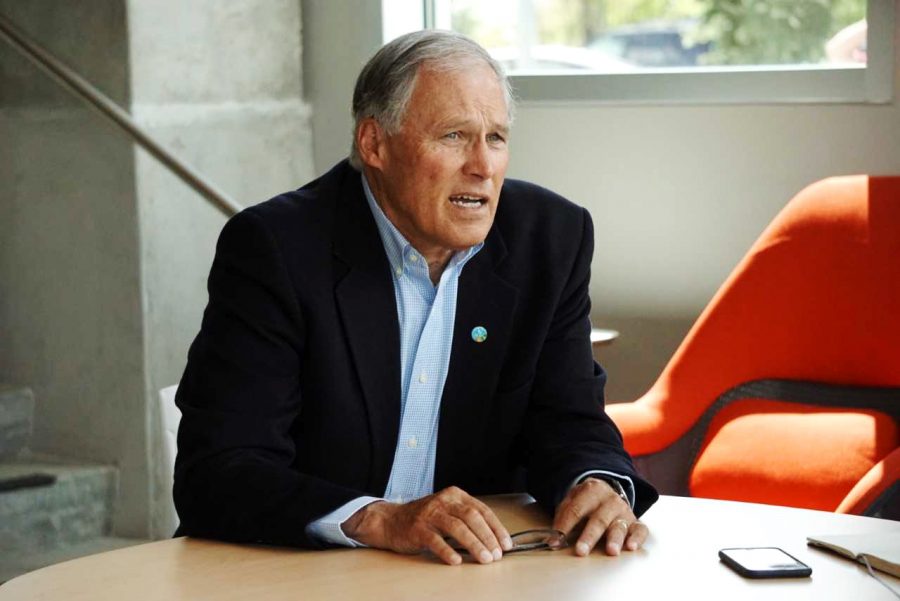Support renewable energy in Washington
Diverse, clean power sources are only way to guard against depletion of fossil fuels, economic plight
ANA MARIA ALANIZ MENDOZA | DAILY EVERGREEN FILE
Supporting clean energy initiatives like Gov. Jay Inslee’s Executive Order 14-04 ensures the environment and economy don’t collapse.
September 12, 2018
Washington is known for its green energy in a polluted world. As its citizens, we should continue to support this agenda for the benefit of all.
Governor Jay Inslee issued Executive Order 14-04 in April 2014, beginning an initiative to address the effects of climate change by providing tax exemptions and programmed support for those fitting certain criteria.
Pooled experts from major stakeholders, namely WSU, were used to evaluate and pursue improvement of the program. The WSU Energy Program has worked closely with the Department of Commerce in this pursuit, working various projects from 2014 to present.
Our school is integral to the progress of renewable resources in this state and as its students, we must continue to support the incentivization of clean power and increases in renewable energy essential to Washington’s prosperity.
Critics of clean power argue that because Washington has the second-cleanest energy grid in the U.S., we shouldn’t be investing so heavily into renewable resources.
Two-thirds of Washington’s energy comes from hydroelectric power sources that consistently produce an excess of electricity. Another 10 percent is attributed to biomass and wind resources, with less than 1 percent to solar power, according to the U.S. Energy Information Administration.
By these percentages, Washington seems safe from the effects of fossil fuel dependence. While we are not entirely bound to fossil fuel for power, it still functions as an important revenue source for the state.
Though we do not produce any raw fossil fuel, Washington has the fifth-largest refining capacity in the U.S. and supplies Oregon with 90 percent of its petroleum.
With few publicly available biofuels, most vehicles must use gasoline or petroleum in their engines. This demand accounts for 37 percent of Washington energy use, resulting in a large import market.
We undoubtedly need fossil fuel, which is why we must prepare for a world without it.
Fossil fuels are the primary provider of electricity worldwide. As such, they are being consumed at higher rates than ever before. Though estimates range anywhere from 50 to 100 years, there is undoubtedly a finite amount, and that is without considering the carbon budget.
Climate change’s exact impact can be debated, but its existence cannot. To minimize the impact, a carbon budget was proposed by the Intergovernmental Panel on Climate Change. This means leaving two-thirds of fossil fuels in the ground, reducing the years left of fossil fuel availability by the same margin.
We may be able to depend on fossil fuel for some decades to come, but when it’s gone, we must have an alternative to avoid making the same mistake twice.
The issue with fossil fuel is that it is finite. By diversifying into many forms of energy collection, Washington is safer should a particular source become insufficient. Of concern is our reliance on hydroelectricity.
One of the effects of climate change has been the loss of glaciers. As the Columbia is a glacial-fed river, the hydro dams it supports are likely to have more unstable seasons.
“Effects of climate change on water supplies, public health, coastal and storm damage, wildfires and other impacts will cost Washington almost $10 billion per year after 2020,” according to Executive Order 14-04.
While we can rely on dams for power now, it is best we don’t rely on them alone in the future.
The solution: diverse energy projects.
Solar energy is the least-utilized green resource in Washington, less than 1 percent of total energy production. Many solar projects are already underway statewide and any project of ours would be a welcome addition to a growing trend. Wave-charged additions are also being tested, though little can be said of what comes from them.
Individual projects help, but the most change is achieved by electing clean energy-friendly candidates — ones who recognize a changing world and continue to prepare our state for prosperity within it. One whose actions have already begun this process.
In 2020, the re-election of Jay Inslee as governor ensures that a cleaner, freer fueled state comes one step closer to reality.








